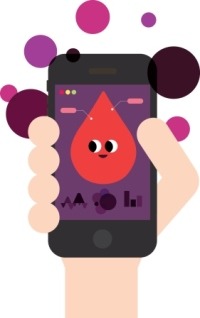The future of biosensors and nanotechnology: A conversation with Sonia Contera
 Imagine a future where diabetes is monitored and managed, not with finger prick blood tests and regular insulin injections, but with a small sensor implanted under the skin that monitors blood sugar levels, releases insulin as needed and communicates the details to a smart phone. Welcome to the subatomic world of nanotechnology. With developments in the field, it is a future that we could be living in not too far from now. As I heard during my recent conversation with Dr Sonia Contera, Co- Director of the Oxford Martin Programme on Nanotechnology, biosensors are one of the most promising medical applications of nanotechnology, and likely to be one of the first to be realised.
Imagine a future where diabetes is monitored and managed, not with finger prick blood tests and regular insulin injections, but with a small sensor implanted under the skin that monitors blood sugar levels, releases insulin as needed and communicates the details to a smart phone. Welcome to the subatomic world of nanotechnology. With developments in the field, it is a future that we could be living in not too far from now. As I heard during my recent conversation with Dr Sonia Contera, Co- Director of the Oxford Martin Programme on Nanotechnology, biosensors are one of the most promising medical applications of nanotechnology, and likely to be one of the first to be realised.
The field of nanotechnology is truly fascinating, and one that has really only developed over the last 10–20 years, with the invention of microscopes that allow us to see objects at the nanoscale. Two key developments in this field were the improvements in the electron microscope and the development of scanning probe microscopes. Dr Contera was an undergraduate studying physics when these developments were taking place and they sparked her interested in nanotechnology, which allowed her to apply her physics knowledge to biology, chemistry and medicine.
In short, Dr Contera does research on basic science at the nano-scale; using tools to better understand the basic biological mechanisms and applying this information to medicine. With a greater understanding of cell processes, cell communication and disease development it is hoped that new strategies to combat disease will be identified. These nanotechnology techniques do not replace the chemistry or biology techniques but it provides a new layer of information to help progress research.
Take for example the development of a cancerous tumour; these cells are usually softer than normal cells and communicate differently with the cells around them. These attributes, such as cell hardness, cannot be detected with standard chemistry techniques, but they can be detected with nanotechnology techniques, which may give us new methods of identifying cancerous cells for delivery of targeted drug treatments.
Improved drug delivery techniques are not the only applications of nano-technology in the medical field; improvements in tissue regeneration, enhanced medical imaging techniques and new medical diagnostics are all expected to impact medicine in the not-too-distant future.
Regenerative medicine – repairing or regenerating tissues or organs damaged by disease or injury – has the potential to have a huge impact on medical treatment, across a number of therapy areas. By using nanotechnology techniques to understand how cells communicate with one another, and identifying and measuring the mechanical signals they use, it is hoped that therapies can be developed that harness the immense powers of regeneration of the human body, just by providing it with the right information. Take tendon regeneration as an example: tendons do not tend to heal well under normal circumstances, leading to the development of scar tissue. By carrying out nano-scale investigation of how tendon cells behave, how they react to force and how they communicate, it may be possible to create therapies that provide the cells with the right information for tendon regeneration, without scar tissue formation.
Nanotechnology is not just making a difference in the medical field; there are significant research programs into energy, food & packaging, textiles, mobile communications and building materials to name a few. In fact research is being translated across fields as in the development of biomimetic materials. For example, there are programs looking at how the body produces energy using nano-scale motors (ATPase’s); in the future this may lead to the understanding needed to create materials that can generate power, just using body heat.
Nano-technology is already starting to be utilised in everyday products. According to the Project on Emerging Nanotechnologies website, over 1300 nanotechnology-enabled consumer products are already available including; non-stick cookware, self-cleaning windows and numerous products containing nano-scale silver particles, used for their antimicrobial properties.
It seems that nanotechnology is going to be the future of many areas of our lives, and is already – perhaps unknowingly – part of some areas now, so what are the possible barriers to this movement?
Regulation of nano-materials is one of the most obvious potential barriers to progress in this area; if the approach is too cautious, leading to overregulation, production of nano-materials could be limited. In Europe, and in the US, there are a number of groups looking into the toxicity of nano-materials and the evidence-based research needed to demonstrate safety. Hand in hand with addressing these safety concerns is the issue of addressing public opinion. A hostile public opinion, something that is already apparent amongst some groups (and in some cases has even resulted in violent actions against those involved in nano-research), could have a slowing effect on research programs. Such is the concern that the public may be scared or angry about the use of nanoparticles, that some companies do not make claim to the use of this technology in their products. Take sun tan creams for example; many use nano-sized ingredients to absorb UV light – they are safer than chemical alternatives, and yet manufacturers are not selling the benefits of this technology because of public fears, particularly in Europe.
The concerns of the general public is a difficult area to tackle as there are paradoxes in opinion across product types; while suncreams are potentially deemed ‘unacceptable’, most people are more than happy with the nanotechnology being used in their iPhones; nano-technology used in food packaging is likely to be met with resistance, but a life-saving cancer treatment using nanotechnology will be welcomed.
As with all research topics, it will be no surprise that another potential barrier to breakthroughs in the future is funding. Nanotechnology funding is already being restricted by willingness to invest and by the geographical availability of funding.
Although major breakthroughs are expected in medicine, the pharmaceutical industry has so far been unwilling to fund nanotechnology projects, preferring instead to watch and wait, picking up university spin-offs once there is some progress in the technology. Investments in early research, in areas such as biosensors, are perhaps surprisingly, coming from companies like Panasonic.
Geographically, funding is becoming increasingly difficult to secure in Europe and particularly in the UK. This is a field in which Dr Contera thinks the UK could have been a world leader, with well qualified people working in centres of excellence. However, with falling investments in the region a ‘brain-drain’ is taking place, with many experts moving to Asia where the funding levels are considerably better. Once Europe starts to lag behind in this area it will be difficult to catch up. Major breakthroughs will likely happen, particularly in material fabrication, and once this happens – once nano-materials fabrication is mastered – everything will change; there will be new materials for everything we build.
Dr Contera is clearly very passionate about this fascinating area of research at a time of such great potential for significant change. Her response when asked what she loves about her work captures the excitement of this area of research “I love the topic; for the first time in history we can study biological systems and understand them, predict them and design things based on the knowledge we get from them. I love the people I work with; I work across lots of fields; biology, medicine, with hospitals, with high-tech technology labs in Japan, it is an international environment. I feel like I am at the beginning of a huge intellectual revolution”.
It is an intellectual revolution which if guided, funded and researched correctly, could change all of our lives for the better. Again imagine a future where biosensors have changed the practice of medicine, where we can use super-light materials that won’t break and we don’t need metals anymore, and where we have mastered energy generation so we don’t need oil anymore. The nature of the planet we live in would change for us all. Surely that’s got to be something worth investing in?
 David Coleiro is a founding partner at www.strategicnorth.com, and this interview is adapted from the book Strategic Tales by Strategic North. To request your free copy please email him at info@strategicnorth.com.
David Coleiro is a founding partner at www.strategicnorth.com, and this interview is adapted from the book Strategic Tales by Strategic North. To request your free copy please email him at info@strategicnorth.com.
Previous interviews by David Coleiro:
- With Tali Sharot on the Science of Optimism
- With Alvaro Fernandez on the Future of Brain Health: Part 1 and Part 2


